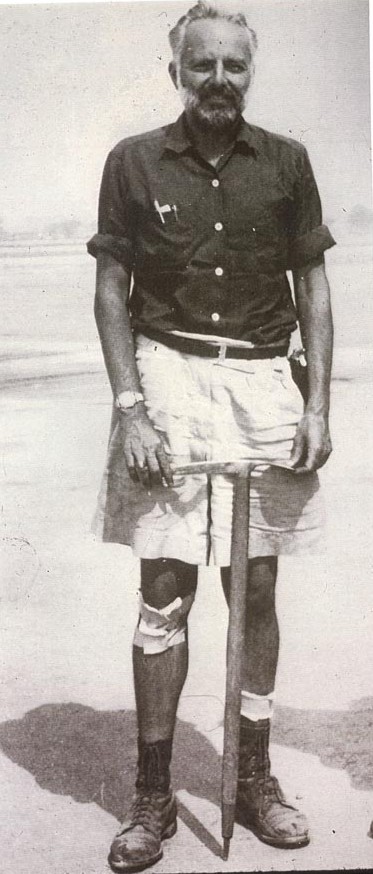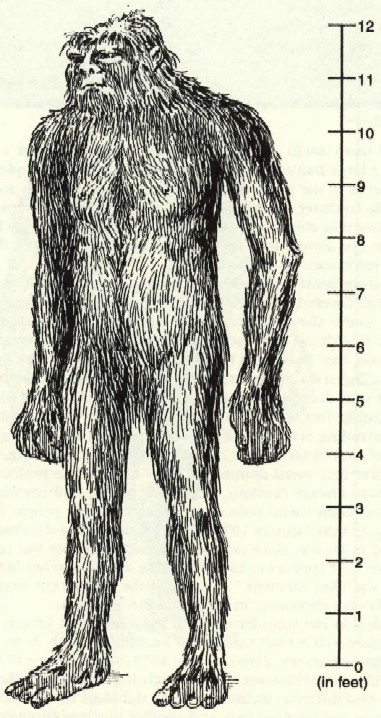The Name Game: The Trinities
Posted by: Loren Coleman on May 3rd, 2007

Tom Slick searched for Giant Salamanders in the Trinity Alps of California.
I see that John Kirk has posted the article about the recent rumblings concerning a “giant black reptile” (gator? lizard? salamander?) being seen in British Columbia.
The location of the recent sightings is familiar to Cryptomundo readers, mostly because Pitt Lake was where a huge example of Sasquatch (below) was seen years ago.
But also the new “reptilian” thing from BC was spied coincidentally in a ravine at Trinity Western University in Langley, B.C., and reminds me of the stories of the Trinity Alps Giant Salamanders (amphibians, but some people think they look like reptiles).
Hey, after all it is just a coincidence that they both have the “Trinity” name overlapping these Giant Salamander stories, don’t you think? There’s nothing sinister or spiritual about the name “Trinity,” I suppose, right? There’s no need to bring in the reports of cryptid baboon-like animals along the Trinity River in Texas, is there? This kind of stream-of-consciousness leads nowhere, correct? Before you know it people will say I’m talking about the Grassy Knoll, the Triple Overpass, and the nearby Trinity River close to Dealey Plaza.
“I shall be accused of having assembled lies, yarns, hoaxes, and superstitions…I offer the data,” said Charles Fort. You all can do with this what you will.
For more information on the notion that names given to certain areas hide the deeper history of cryptozoology and other wonders at specific locations, see Chapter 22, “The Name Game,” and Chapter 3, “Devil Names and Fortean Places,” in Mysterious America: The Ultimate Guide to the Nation’s Weirdest Wonders, Strangest Spots, and Creepiest Creatures.
Of course, the number one historic figure in search of Giant Salamanders was Texas oil and beef millionaire Tom Slick. My biography documents his quests for the Abominable Snowmen, Loch Ness Monsters, Sumatran rhinos, Bigfoot, and Orang Pendek, and – yes – the Trinity Alps’ Giant Salamanders. See my book, Tom Slick: True Life Encounters in Cryptozoology (Fresno: Linden Press, 2002). One of his favorite quests was for those Giant Salamanders in California because he brought along his sons.

Ah, the name game…it’s June 1965 and a giant four-toed Sasquatch is seen near Pitt Lake, British Columbia. Fast forward 42 years later and now we’re talking about giant black alligators or giant salamanders from there. Drawing from The Field Guide of Bigfoot and Other Mystery Primates.
“Trinity,” once, twice, three times. And the “Pitt,” too, humm? I won’t even discuss “Bluff” Creek today….but that doesn’t stop you from talking about any of it.
About Loren Coleman
Loren Coleman is one of the world’s leading cryptozoologists, some say “the” leading living cryptozoologist. Certainly, he is acknowledged as the current living American researcher and writer who has most popularized cryptozoology in the late 20th and early 21st centuries.
Starting his fieldwork and investigations in 1960, after traveling and trekking extensively in pursuit of cryptozoological mysteries, Coleman began writing to share his experiences in 1969. An honorary member of Ivan T. Sanderson’s Society for the Investigation of the Unexplained in the 1970s, Coleman has been bestowed with similar honorary memberships of the North Idaho College Cryptozoology Club in 1983, and in subsequent years, that of the British Columbia Scientific Cryptozoology Club, CryptoSafari International, and other international organizations. He was also a Life Member and Benefactor of the International Society of Cryptozoology (now-defunct).
Loren Coleman’s daily blog, as a member of the Cryptomundo Team, served as an ongoing avenue of communication for the ever-growing body of cryptozoo news from 2005 through 2013. He returned as an infrequent contributor beginning Halloween week of 2015.
Coleman is the founder in 2003, and current director of the International Cryptozoology Museum in Portland, Maine.










I have always found the “coincidences” quite amazing when talking about similar names. There is something that causes people to name the areas what they are. By the way, was that the trinity river near Dallas, Tx? When was that? I lived in Dallas for 3 years while going to school.
hey loren very informative new article about bigfoot & wildlife of the trinites. thanks bill 🙂
Loren, call it “stream of consciousness”, “brainstorming”, “lateral thinking” or, as I call it, “chuckin’ stuff at the wall and seein’ what sticks”, but unrestrained free association of this kind is only “pointless” – or more accurately, “frightenin'” – to people who are so set in their ideas they don’t want to risk the possibility of being accidentally led into areas of thought which might change the way they want to look at the world.
Besides which, I suspect reality might more closely resemble the musical form known as the fugue than other more straightforward type of composition, in which case there may be a bit more going on under the surface of the things you touched upon than mere coincidence.
I also suspect you yourself don’t entirely preclude this peculiar possibility either…